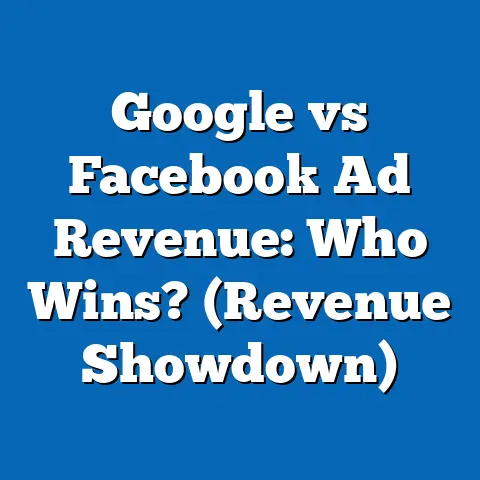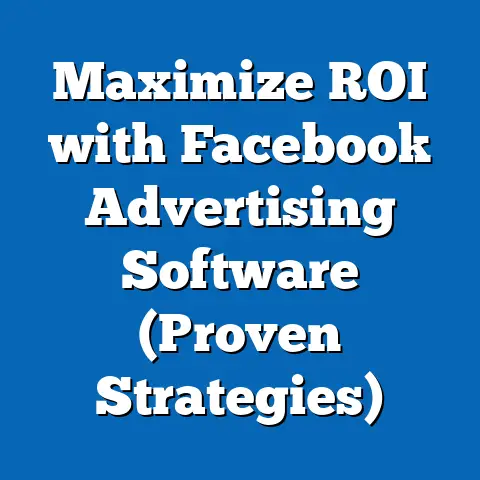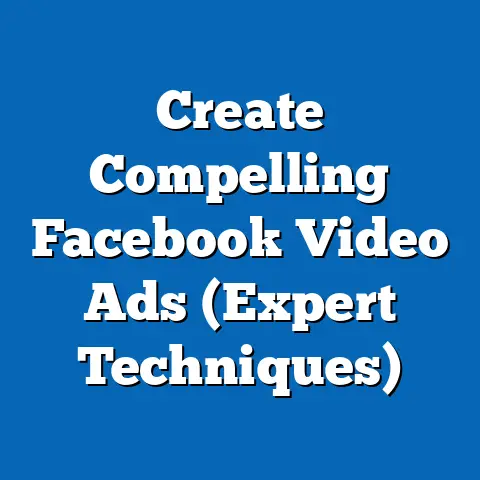Optimal Final Cut Video Codec for Facebook Ads (Expert Guide)
Imagine a bustling digital marketplace, a place where brands jostle for attention, vying for those precious few seconds of a user’s focus. In this arena, a well-crafted video ad can be the ultimate game-changer, the difference between a successful campaign and one that fades into the background. As someone who’s spent years crafting video strategies for social media, I’ve seen firsthand how powerful video is, and how crucial it is to get every detail right – especially the video codec. Studies consistently show that video ads on Facebook outperform static images in terms of engagement and conversions. But, and this is a big but, if your video is blurry, slow to load, or just doesn’t look professional, you’re throwing money away. That’s why choosing the right video codec in Final Cut Pro is paramount. It’s about ensuring your videos not only maintain their quality but also perform seamlessly across a multitude of devices and platforms. This guide dives deep into the world of video codecs, specifically for Facebook ads, to help you create videos that captivate your audience and drive results.
Understanding Video Codecs and Their Importance
So, what exactly is a video codec? Think of it as a translator between the raw video data and the way it’s stored and played back. It’s a piece of software (or hardware) that compresses video data for storage and transmission, and then decompresses it for playback. Without codecs, video files would be enormous and impractical to share or stream online.
Essentially, a video codec is a specific method used to encode and decode video data. It determines how the video is compressed and decompressed, affecting both the file size and the visual quality.
Why is this important? Because the right codec ensures your video looks great, loads quickly, and plays smoothly on Facebook.
There are two main types of video compression:
- Lossy Compression: This type of compression reduces file size by discarding some video data. This results in smaller files that are easier to share, but it can also lead to a loss of visual quality, especially if the compression is too aggressive.
- Lossless Compression: This type of compression preserves all the original video data, resulting in larger files but no loss of quality. Lossless codecs are typically used for archival purposes or for editing where you need to maintain the highest possible quality.
For Facebook ads, you’ll almost always be using a lossy codec. The key is to find the right balance between file size and visual quality.
Why is selecting the right codec critical for Facebook ads?
- Loading Times: No one wants to wait for a video to load. If your video takes too long to start playing, people will scroll right past it. The right codec helps keep file sizes manageable, ensuring fast loading times.
- Playback Quality: A pixelated or blurry video is a major turn-off. The right codec preserves visual quality, making your ad look professional and engaging.
- Audience Retention: Poor video quality can lead to viewers dropping off quickly. A clear, crisp video keeps people watching, increasing the chances they’ll see your entire message.
Takeaway: Understanding video codecs is the first step to creating effective Facebook video ads. Choose wisely, and you’ll see a significant improvement in your ad performance.
Popular Video Codecs Compatible with Final Cut Pro
Final Cut Pro offers a variety of codecs to choose from, each with its own strengths and weaknesses. Let’s take a look at the most common ones and how they fare in the context of Facebook advertising.
H.264: The Workhorse
H.264 (also known as AVC or Advanced Video Coding) is often the go-to codec for Facebook ads, and for good reason. It offers a great balance of quality and file size, making it ideal for online video.
Advantages:
- Widely Supported: H.264 is supported by virtually every device and platform, including Facebook.
- Good Quality: It provides excellent visual quality at relatively small file sizes.
- Efficient Compression: H.264 is a highly efficient codec, meaning it can compress video data without sacrificing too much quality.
Disadvantages:
- Not Ideal for Editing: While you can edit H.264 footage, it’s not as efficient as some other codecs designed specifically for editing.
- Can Be Lossy: As a lossy codec, H.264 does discard some video data, which can lead to a loss of quality if the compression is too aggressive.
My Experience: I’ve used H.264 for countless Facebook ad campaigns, and it’s consistently delivered excellent results. It’s reliable, efficient, and produces high-quality videos that look great on any device.
ProRes: The Pro’s Choice
ProRes is a family of codecs developed by Apple, designed specifically for video editing. It’s a high-quality, intermediate codec that’s often used for editing and post-production workflows.
Advantages:
- Excellent Quality: ProRes preserves a lot of detail and color information, making it ideal for editing and color grading.
- Efficient Editing: It’s designed for efficient editing, meaning it’s easy to work with in Final Cut Pro and other editing software.
- Multiple Flavors: ProRes comes in several different flavors, each with its own balance of quality and file size (e.g., ProRes 422, ProRes 422 HQ, ProRes 4444).
Disadvantages:
- Large File Sizes: ProRes files are significantly larger than H.264 files, which can make them impractical for direct upload to Facebook.
- Not as Widely Supported: While ProRes is supported by many editing programs, it’s not as universally supported as H.264.
When to Use ProRes for Facebook Ads:
You typically wouldn’t upload a ProRes file directly to Facebook. However, ProRes is an excellent choice for your master file. Edit and color grade your video in ProRes, then export a smaller H.264 version specifically for Facebook. This ensures you’re working with the highest possible quality throughout the editing process.
HEVC (H.265): The New Kid on the Block
HEVC (High Efficiency Video Coding), also known as H.265, is a newer codec that offers better compression rates than H.264. This means you can achieve the same visual quality at smaller file sizes, or higher quality at the same file size.
Advantages:
- Superior Compression: HEVC offers better compression than H.264, resulting in smaller file sizes or higher quality.
- Improved Efficiency: It’s more efficient than H.264, meaning it can encode and decode video data more quickly.
Disadvantages:
- Compatibility Issues: HEVC is not as widely supported as H.264, particularly on older devices.
- Processing Power: HEVC requires more processing power to encode and decode, which can be a challenge on older computers.
HEVC and Facebook:
Facebook does support HEVC, but it’s important to test your videos on different devices to ensure they play correctly. Also, consider your target audience. If they’re likely to be using older devices, H.264 might be a safer bet.
Here’s a quick comparison table:
| Codec | Advantages | Disadvantages | Best Use Case for Facebook Ads |
|---|---|---|---|
| H.264 | Widely supported, good quality, efficient compression | Not ideal for editing, can be lossy | Exporting final videos for Facebook upload |
| ProRes | Excellent quality, efficient editing, multiple flavors | Large file sizes, not as widely supported | Editing and color grading; creating a high-quality master file for later export to H.264 |
| HEVC | Superior compression, improved efficiency | Compatibility issues, requires more processing power | Exporting final videos for Facebook upload, if you’re confident your target audience has compatible devices |
| Codec | Advantages | Disadvantages | Best Use Case for Facebook Ads |
|---|---|---|---|
| H.264 | Widely supported, good quality, efficient compression | Not ideal for editing, can be lossy | Exporting final videos for Facebook upload |
| ProRes | Excellent quality, efficient editing, multiple flavors | Large file sizes, not as widely supported | Editing and color grading; creating a high-quality master file for later export to H.264 |
| HEVC | Superior compression, improved efficiency | Compatibility issues, requires more processing power | Exporting final videos for Facebook upload, if you’re confident your target audience has compatible devices |
Takeaway: H.264 is generally the safest and most reliable choice for Facebook ads. ProRes is great for editing, and HEVC can offer better compression, but be mindful of compatibility issues.
Best Practices for Encoding Videos for Facebook Ads
Now that you understand the different codecs, let’s dive into the specific settings you should use when encoding your videos for Facebook ads.
Recommended Video Settings
Facebook has specific recommendations for video settings to ensure optimal playback and performance. Here’s a breakdown:
- Resolution: Aim for the highest resolution possible while keeping file sizes manageable. 1080p (1920×1080) is a good starting point. For square videos (used in some placements), 1080×1080 is ideal.
- Bitrate: Bitrate refers to the amount of data used to encode the video per second. Higher bitrates result in better quality, but also larger file sizes. For 1080p videos, a bitrate of 8-10 Mbps is a good balance.
- Frame Rate: Use the same frame rate as your source footage. Typically, this will be 24, 25, or 30 frames per second (fps).
- Audio Codec: AAC (Advanced Audio Coding) is the recommended audio codec for Facebook ads.
- Audio Bitrate: Aim for an audio bitrate of 128 kbps or higher.
Adjusting Settings in Final Cut Pro
Here’s a step-by-step guide on how to export a video with the optimal codec and settings in Final Cut Pro:
- Select Your Project: Open your project in Final Cut Pro.
- Share Menu: Go to File > Share > Master File.
- Settings Tab: In the Share window, click on the “Settings” tab.
- Format: Choose “Computer.”
- Codec: Select “H.264.”
- Resolution: Set the resolution to your desired value (e.g., 1920×1080).
- Bitrate: Click the “Video and Audio” tab. Set the bitrate to 8-10 Mbps. You can choose “Automatic” or “Custom” to set the bitrate manually. I prefer “Custom” for more control.
- Audio Settings: Ensure the audio codec is set to AAC and the bitrate is 128 kbps or higher.
- Next: Click “Next” and choose a location to save your file.
- Save: Click “Save” to export your video.
Pro Tip: Consider creating a custom export preset in Final Cut Pro with these settings. This will save you time and ensure consistency across all your videos.
Aspect Ratios for Different Placements
Facebook supports a variety of aspect ratios for video ads, depending on the placement. Here are some common examples:
- News Feed: 16:9 (landscape), 1:1 (square), 4:5 (vertical)
- Stories: 9:16 (vertical)
- In-Stream Video Ads: 16:9 (landscape)
- Right Column Ads: 1:1 (square)
It’s crucial to create videos in the correct aspect ratio for each placement to avoid cropping or distortion. Final Cut Pro makes it easy to create projects with different aspect ratios.
My Experience: I’ve found that square (1:1) and vertical (4:5) videos tend to perform well in the News Feed, as they take up more screen real estate on mobile devices. For Stories, vertical (9:16) is obviously the way to go.
Takeaway: Pay close attention to video settings and aspect ratios to ensure your ads look their best on Facebook. Use H.264 as your primary codec and adjust the resolution and bitrate to achieve a good balance of quality and file size.
Testing and Analyzing Video Performance
Creating great videos is only half the battle. You also need to test and analyze their performance to see what’s working and what’s not.
A/B Testing
A/B testing involves creating multiple versions of your video ad with different codecs, settings, or content, and then running them simultaneously to see which performs best.
For example, you could test two versions of your video: one encoded with H.264 at 8 Mbps and another encoded with H.264 at 10 Mbps. Run both ads to the same target audience and track their performance.
How to Set Up A/B Tests:
Facebook’s Ads Manager has a built-in A/B testing feature that makes it easy to create and run these tests. Simply create two or more ad sets with different video versions and let Facebook’s algorithm determine which performs best.
Key Metrics to Track
Here are some key metrics to track when analyzing video performance on Facebook:
- View Rate: The percentage of people who saw your ad and watched at least a certain amount of the video (e.g., 3 seconds, 10 seconds).
- Engagement Metrics: Likes, comments, shares, and saves. These metrics indicate how engaging your video is.
- Click-Through Rate (CTR): The percentage of people who clicked on the call-to-action in your ad.
- Conversion Rate: The percentage of people who took the desired action after watching your video (e.g., made a purchase, signed up for a newsletter).
- Cost Per Result (CPR): The cost of achieving a specific result (e.g., a view, a click, a conversion).
Interpreting the Data
Once you’ve collected enough data, it’s time to analyze it and draw conclusions.
- High View Rate, Low Engagement: This suggests your video is visually appealing but not compelling enough to encourage interaction. Try improving your messaging or adding a stronger call-to-action.
- Low View Rate, High Engagement: This suggests your video might not be catching people’s attention initially, but those who do watch it find it engaging. Try improving your thumbnail or the first few seconds of your video.
- High CTR, Low Conversion Rate: This suggests your ad is driving traffic to your website or landing page, but something is preventing people from converting. Review your landing page and make sure it’s optimized for conversions.
My Experience: I once ran an A/B test on two video ads with slightly different intro sequences. The ad with the more visually engaging intro had a significantly higher view rate, even though the rest of the video was identical. This simple test helped me identify a key area for improvement and ultimately boosted the overall performance of the campaign.
Takeaway: Don’t just create videos and hope for the best. Test, analyze, and optimize your videos based on data to maximize their impact.
Case Studies and Success Stories
Let’s take a look at some real-world examples of brands that have successfully used optimal video codecs for their Facebook ads.
Case Study 1: E-commerce Brand Boosts Sales with High-Quality Video
An e-commerce brand selling clothing wanted to increase sales through Facebook ads. They invested in high-quality video production, creating visually stunning videos showcasing their products. They used ProRes for editing and color grading, then exported H.264 versions for Facebook upload.
Results:
- The brand saw a 30% increase in sales compared to previous campaigns using static images.
- Their video ads had a significantly higher engagement rate and click-through rate.
- They attributed their success to the high-quality video, which made their products look more appealing and trustworthy.
Lesson Learned: Investing in high-quality video production can pay off in a big way.
Case Study 2: Local Restaurant Drives Traffic with Engaging Video Ads
A local restaurant wanted to drive more foot traffic to their establishment. They created short, engaging video ads showcasing their delicious food and inviting atmosphere. They used H.264 for their videos and optimized the resolution and bitrate for Facebook.
Results:
- The restaurant saw a 20% increase in foot traffic after launching their video ad campaign.
- Their video ads generated a lot of positive comments and shares on Facebook.
- They found that video ads were more effective than static image ads at capturing people’s attention and driving them to visit the restaurant.
Lesson Learned: Even small businesses can benefit from using video ads on Facebook.
Case Study 3: Software Company Increases Sign-Ups with Explainer Videos
A software company wanted to increase sign-ups for their platform. They created a series of explainer videos demonstrating the features and benefits of their software. They used HEVC (H.265) for their videos to achieve smaller file sizes without sacrificing quality.
Results:
- The company saw a 40% increase in sign-ups after launching their video ad campaign.
- Their video ads had a high view rate and a low cost per sign-up.
- They found that HEVC was a good choice for their videos, as it allowed them to deliver high-quality content to a wider audience without overloading their servers.
Lesson Learned: HEVC can be a good option for companies looking to optimize video delivery.
Takeaway: These case studies demonstrate the power of video advertising on Facebook. By using the right codecs and settings, you can create videos that engage your audience, drive results, and ultimately grow your business.
Conclusion: The Future of Video Advertising on Facebook
The world of video advertising on social media is constantly evolving. New codecs are emerging, Facebook’s algorithms are changing, and user preferences are shifting. To stay ahead of the curve, it’s crucial to stay updated on the latest trends in video technology and codec advancements.
The optimal video codec for Facebook ads is not just a technical detail; it’s a strategic advantage in an increasingly competitive digital landscape. By mastering the art of video encoding, you can create videos that capture attention, engage your audience, and drive results.
As someone who’s been in the trenches of digital marketing for years, I can tell you that video is only going to become more important in the future. So, invest the time to learn the fundamentals of video codecs, experiment with different settings, and track your results. Your future marketing success depends on it!
Here are some final takeaways:
- H.264 is your reliable workhorse. Start with H.264 for your Facebook ad videos. It’s widely compatible and offers a good balance of quality and file size.
- Use ProRes for editing and mastering. If you’re serious about video quality, use ProRes for your editing workflow.
- Consider HEVC for optimized delivery. HEVC can offer better compression, but be mindful of compatibility issues.
- Test, analyze, and optimize. Don’t just create videos and hope for the best. Test different codecs, settings, and content to see what works best for your audience.
- Stay updated. The world of video advertising is constantly evolving. Keep learning and experimenting to stay ahead of the curve.
By following these guidelines, you’ll be well on your way to creating high-performing video ads that drive results on Facebook. Good luck, and happy advertising!






